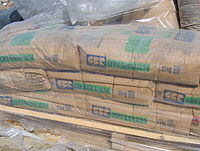
Photo from wikipedia
Abstract Portland cement CEM I is obtained from (95–97%) of clinker and (3–5%) of gypsum, according to EN 197-1 (2011) standard. Sulfur trioxide SO3 is the main component of gypsum… Click to show full abstract
Abstract Portland cement CEM I is obtained from (95–97%) of clinker and (3–5%) of gypsum, according to EN 197-1 (2011) standard. Sulfur trioxide SO3 is the main component of gypsum (Calcium Sulfate Dihydrate CaSO4·2H2O), it may also originate from clinker, the previous standard has limited its content in cement at 4%. It is known that the gypsum acts as a cement setting regulator, however, an appropriate gypsum quantity (optimum) may improve other properties such as: mechanical response, dimensional variations and hydration process. This optimum gypsum content is related to several parameters, namely: SO3 %, cement SSB (specific surface Blaine), C3A % and alkali %. The aim of this work is to find, through an experimental protocol, the optimum gypsum content of an Algerian Portland cement CEM I. 10 variants containing various % of gypsum were formulated, where properties of anhydrous cements, cement pastes and normalized cement mortars were studied. Results show that when gypsum is added below or above the optimum, water demand for normal consistency, setting times, compressive strength, heat of hydration, swelling, drying shrinkage and hydration degree were adversely affected. It has been experimentally demonstrated that this optimum gypsum content is 5.5% by weight.
Journal Title: Construction and Building Materials
Year Published: 2018
Link to full text (if available)
Share on Social Media: Sign Up to like & get
recommendations!